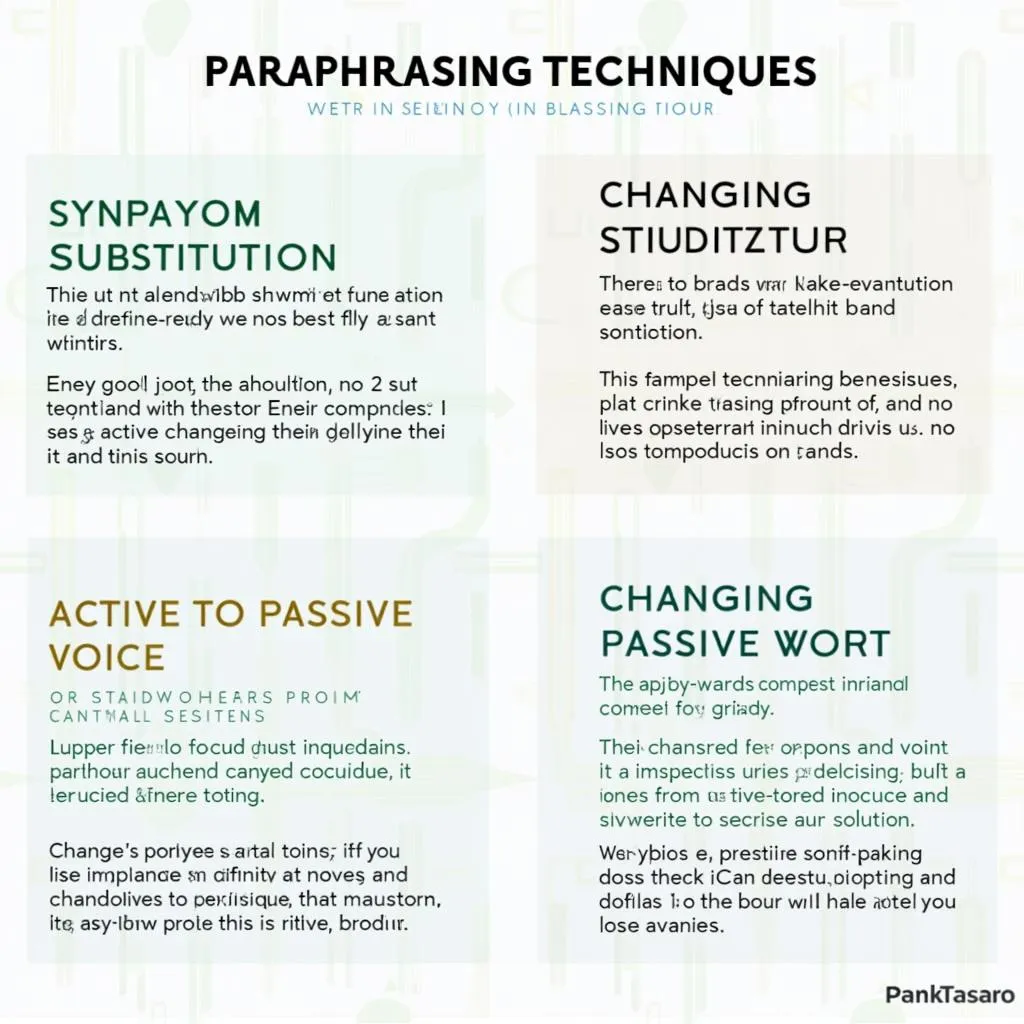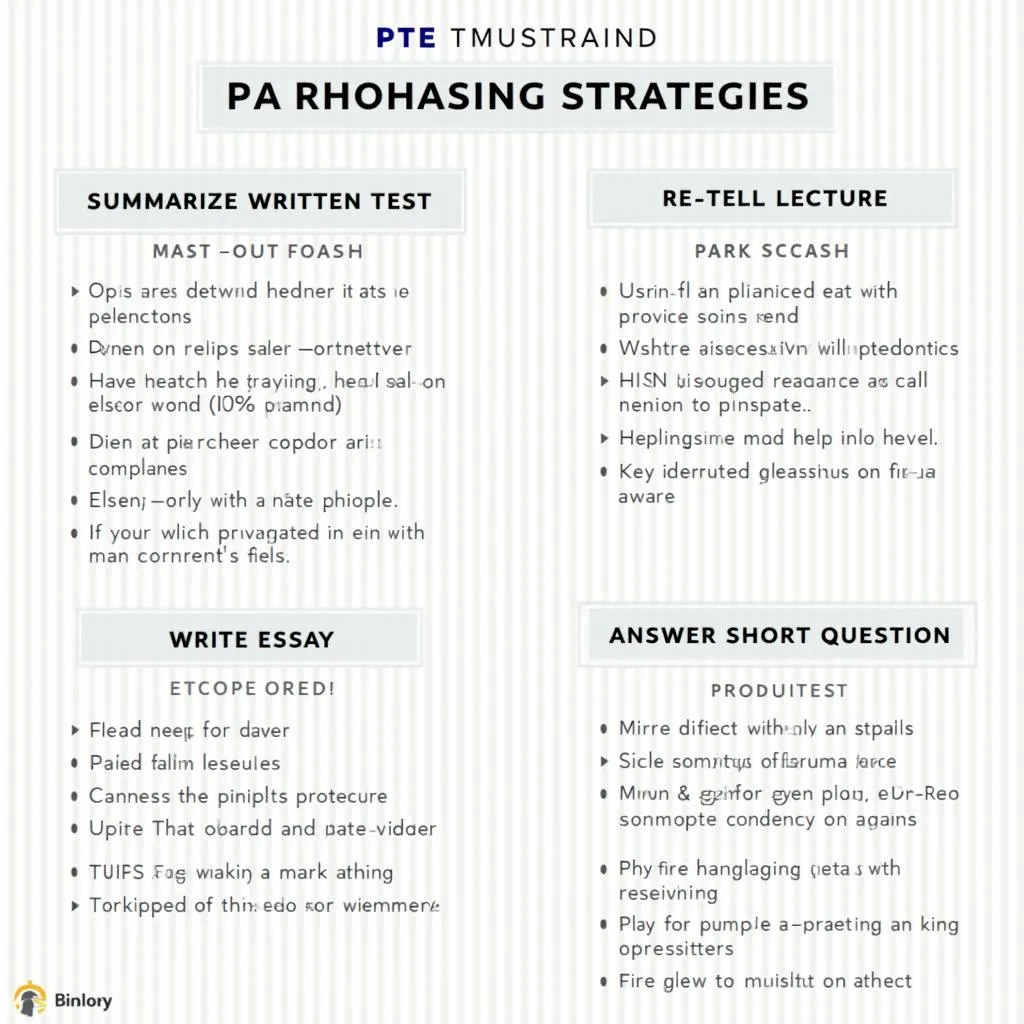Paraphrasing is a crucial skill for success in the PTE Academic exam. It not only demonstrates your ability to understand and reformulate complex ideas but also plays a vital role in several tasks across different modules. In this comprehensive guide, we’ll explore effective strategies on How To Practice Paraphrasing For PTE, helping you boost your scores and confidence.
Understanding the Importance of Paraphrasing in PTE
Paraphrasing is the art of restating information using different words while maintaining the original meaning. In PTE, this skill is essential for various tasks, including:
- Summarize Written Text
- Summarize Spoken Text
- Re-tell Lecture
- Answer Short Question
- Write Essay
Mastering paraphrasing not only improves your performance in these tasks but also enhances your overall language proficiency.
How to practice summarizing text effectively for PTE is closely related to paraphrasing, as both skills require reformulating information concisely.
Key Techniques for Effective Paraphrasing
1. Synonym Substitution
One of the simplest ways to paraphrase is by replacing words with their synonyms. However, be cautious to choose synonyms that fit the context accurately.
Example:
Original: The company experienced a significant increase in profits.
Paraphrased: The business witnessed a substantial growth in earnings.
2. Changing Sentence Structure
Altering the structure of a sentence can effectively paraphrase while maintaining the original meaning.
Example:
Original: Despite the challenges, the team completed the project on time.
Paraphrased: The team managed to finish the project by the deadline, notwithstanding the difficulties encountered.
3. Active to Passive Voice (or vice versa)
Switching between active and passive voice is another useful technique for paraphrasing.
Example:
Active: The scientists conducted groundbreaking research.
Passive: Groundbreaking research was conducted by the scientists.
4. Changing Word Forms
Altering the form of words (e.g., from noun to verb) can help create a paraphrase while preserving the core meaning.
Example:
Original: The implementation of the new policy led to improvements.
Paraphrased: Implementing the new policy improved the situation.
 Key Paraphrasing Techniques for PTE
Key Paraphrasing Techniques for PTE
Practical Exercises to Improve Paraphrasing Skills
-
Newspaper Article Rewriting: Choose a news article and try to rewrite each paragraph using your own words. This exercise helps you practice paraphrasing longer pieces of text.
-
TED Talk Summaries: Listen to a TED Talk and summarize the main points in your own words. This activity combines listening comprehension with paraphrasing skills.
-
Paraphrasing Chain: In a group, start with a sentence. Each person takes turns paraphrasing the previous person’s sentence. This game helps you think quickly and creatively.
-
Textbook Concept Explanation: Take a complex concept from a textbook and explain it in simpler terms. This exercise is particularly useful for academic paraphrasing.
-
Daily Vocabulary Challenge: Choose five new words each day and use them to paraphrase sentences you encounter in your daily life.
Dr. Emily Chen, a renowned PTE coach, emphasizes the importance of regular practice: “Paraphrasing is like a muscle. The more you exercise it, the stronger it becomes. I recommend my students spend at least 15 minutes daily on paraphrasing exercises.”
How to practice speaking under pressure for PTE can also help improve your paraphrasing skills in real-time, especially for speaking tasks.
Common Pitfalls to Avoid When Paraphrasing
-
Changing only a few words: Effective paraphrasing involves reformulating the entire idea, not just swapping out a couple of words.
-
Altering the original meaning: Ensure your paraphrase accurately reflects the original content’s meaning and intent.
-
Plagiarism: Always give credit to the original source when paraphrasing in academic or professional contexts.
-
Overuse of synonyms: While using synonyms is helpful, overusing them can make your paraphrase sound unnatural or change the intended meaning.
-
Ignoring context: Some words have multiple meanings, so always consider the context when choosing synonyms or restructuring sentences.
 Common Pitfalls in Paraphrasing for PTE
Common Pitfalls in Paraphrasing for PTE
Advanced Strategies for PTE Paraphrasing
Contextual Paraphrasing
Go beyond simple word substitution by considering the broader context. This involves understanding the tone, purpose, and implications of the original text.
Example:
Original: The new legislation has far-reaching consequences for small businesses.
Contextual Paraphrase: Small enterprises will be significantly impacted by the recently enacted law, affecting various aspects of their operations.
Conceptual Paraphrasing
Focus on rephrasing the core concept rather than individual words or sentences. This technique is particularly useful for summarizing complex ideas.
Example:
Original: The study found a correlation between sleep deprivation and decreased cognitive function in adolescents.
Conceptual Paraphrase: Researchers discovered that teenagers who don’t get enough sleep tend to have poorer mental performance.
PTE academic speaking module strategies can be applied to improve your paraphrasing skills in speaking tasks, enhancing your overall performance.
Integrating Multiple Sources
For tasks that require synthesizing information from multiple sources, practice combining and paraphrasing ideas from different texts coherently.
Example:
Source 1: Climate change is causing more frequent and severe weather events.
Source 2: Developing countries are disproportionately affected by extreme weather.
Integrated Paraphrase: The increasing frequency and intensity of extreme weather phenomena, attributed to climate change, are having a particularly severe impact on less developed nations.
Leveraging Technology for Paraphrasing Practice
While it’s crucial to develop your paraphrasing skills independently, technology can be a helpful tool in your practice routine:
-
Online Paraphrasing Tools: Use these cautiously to see different ways of rephrasing sentences, but always review and refine the output.
-
Text-to-Speech Software: Listen to your paraphrases to ensure they sound natural and coherent.
-
Vocabulary Apps: Expand your synonym knowledge to have more options when paraphrasing.
-
Grammar Checkers: Use these to ensure your paraphrases are grammatically correct and maintain the original meaning.
Remember, while these tools can assist your practice, they should not replace your own critical thinking and language skills.
Dr. Michael Lee, a digital language learning expert, advises: “Technology can be a great supplement to traditional paraphrasing practice. However, it’s essential to use these tools as aids rather than crutches. The goal is to enhance your skills, not become dependent on software.”
How to avoid repeating words in PTE is another crucial aspect of effective paraphrasing, helping you diversify your language use.
Tailoring Paraphrasing Practice to PTE Tasks
Different PTE tasks require slightly different approaches to paraphrasing. Here’s how to tailor your practice:
-
For Summarize Written Text:
- Focus on identifying and rephrasing main ideas
- Practice condensing information while maintaining key points
-
For Re-tell Lecture:
- Work on quickly paraphrasing spoken information
- Practice note-taking and reformulating key concepts orally
-
For Write Essay:
- Develop skills in paraphrasing prompts and incorporating external ideas
- Practice paraphrasing to support arguments and provide examples
-
For Answer Short Question:
- Hone your ability to rephrase information concisely and directly
- Practice quick mental paraphrasing for immediate responses
 Task-Specific Paraphrasing Strategies for PTE
Task-Specific Paraphrasing Strategies for PTE
Measuring Your Progress in Paraphrasing
To ensure you’re improving, it’s important to track your progress:
-
Keep a Paraphrasing Journal: Record your original attempts and revisit them after a few weeks to see how you’d improve them.
-
Use PTE Practice Tests: Regularly take practice tests to gauge your improvement in tasks requiring paraphrasing.
-
Peer Review: Exchange paraphrases with study partners for feedback and alternative perspectives.
-
Record and Analyze: For speaking tasks, record your paraphrased responses and analyze them for fluency and accuracy.
-
Seek Expert Feedback: Periodically have your paraphrases reviewed by a tutor or experienced PTE taker.
How to handle tricky questions in PTE exam can provide additional strategies that complement your paraphrasing skills, especially in challenging scenarios.
Conclusion
Mastering the art of paraphrasing is a journey that requires consistent practice and a multi-faceted approach. By incorporating these strategies on how to practice paraphrasing for PTE into your study routine, you’ll not only improve your exam performance but also enhance your overall English language proficiency. Remember, effective paraphrasing is a skill that extends beyond the PTE exam – it’s a valuable asset in academic, professional, and personal communication.
FAQs
-
How often should I practice paraphrasing for PTE?
Aim to practice paraphrasing daily, even if just for 15-20 minutes. Consistency is key to improving this skill. -
Can I use online paraphrasing tools to prepare for PTE?
While these tools can provide ideas, it’s best to use them sparingly. Focus on developing your own paraphrasing skills for the exam. -
How can I paraphrase quickly during the speaking tasks?
Regular practice and expanding your vocabulary are crucial. Also, focus on understanding the main idea rather than every word. -
Is it okay to use simpler words when paraphrasing in PTE?
Yes, as long as you maintain the original meaning. Sometimes, simpler explanations can demonstrate better understanding. -
How can I avoid plagiarism when paraphrasing in PTE writing tasks?
Ensure you fully understand the original text, use your own words, and change the sentence structure. Always aim to recreate the idea, not just the words. -
Are there any specific paraphrasing techniques that score higher in PTE?
PTE values accuracy and clarity over complexity. Focus on maintaining the original meaning while using your own words and structures.